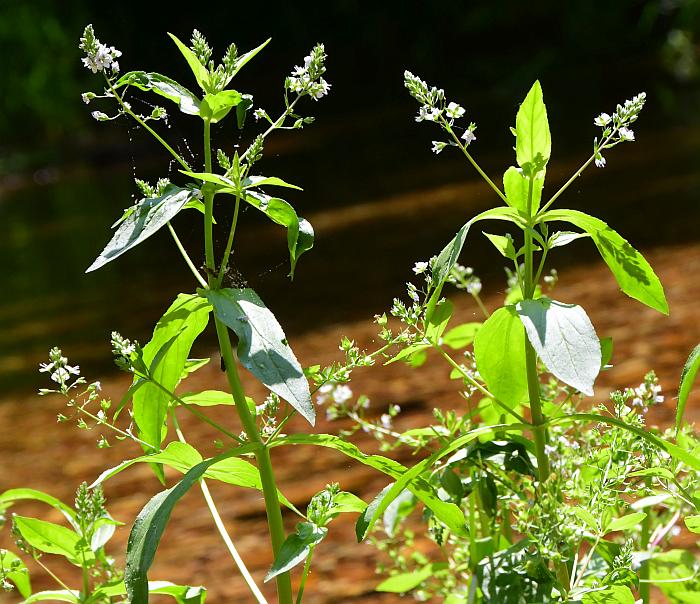Veronica catenata Pennell
Water Speedwell

Native
CC = 10
CW = -5
MOC = 28
© SRTurner
Veronica catenata PennellWater Speedwell | |
 |
Native CC = 10 CW = -5 MOC = 28 |
© SRTurner |
|
Family - Plantaginaceae Habit - Rhizomatous perennial forb, sometimes an emergent aquatic.
Stems - Ascending to erect, or more spreading when submerged, to 60 cm, sometimes from a spreading base, glabrous, sometimes with minute, gland-tipped hairs toward the tip.
Leaves - Opposite, simple, sessile. Lowermost leaves sometimes with short petioles. Blades 2-8 cm long, 3.0-5.0 times as long as wide, lanceolate to oblong-oblanceolate, mostly broadest below the midpoint, sharply to less commonly bluntly pointed at the tip, rounded to truncate or shallowly cordate at the base, often clasping the stems, the margins unlobed, flat, subentire or with widely or irregularly spaced, minute teeth, often mainly toward the tip, the surfaces glabrous or the undersurface inconspicuously glandular-hairy toward the base of the midvein.
Inflorescence - Axillary racemes, these usually in opposite pairs at the stem nodes, open at maturity, with 15-25 flowers, the bracts 1.5-4.0 mm long, much smaller than the foliage leaves, linear to narrowly lanceolate. Flower stalks 2.5-5.0 mm long at flowering (to 7 mm long at fruiting), spreading to ascending at flowering, spreading at a right angle to the axis at fruiting or occasionally some of them slightly ascending or upcurved.
Flowers - Calyces 3.0-3.5 mm long, deeply 4-lobed, the lobes nearly equal, the upper 2 lobes often slightly shorter than the lower 2 lobes, the lobes broadly lanceolate to ovate, glabrous or minutely glandular-hairy toward the base. Corollas 4-lobed, 3-6 mm wide, white to pinkish-tinged or pale blue to pale purple, with darker, pinkish purple to blue veins, the throat greenish-tinged to yellowish-tinged, the lobes loosely cupped upward. Throat of corolla pubescent. Stamens 2, alternating with 3 larger corolla lobes, erect. Filaments 2.5-3.0 mm long, glabrous, whitish near base, purplish near apex. Anthers yellow-orange, 0.5 mm long. Flowering style 3 mm long, glabrous, purplish. Style 1.3-2.0 mm long at fruiting. Ovary green, glabrous, 1 mm broad and long. Capsule slightly compressed, to +/-3.5mm broad and long, dehiscing by 4 valves, brown. Seeds many, tan, -.2mm long.
Fruits - Capsules 2.5-3.0 mm long, slightly wider than long, depressed-obovate to more or less heart-shaped in profile, somewhat turgid, the notch very shallow (0.1-0.3 mm), the surfaces and margins glabrous or a few minute glandular hairs present along the margins, usually dehiscing both along and between the sutures into 4 valves. Seeds numerous, 0.3-0.7 mm long, strongly flattened on one side and somewhat convex on the other, the surfaces appearing smooth or appearing slightly pebbled, light brown to yellowish brown.
Flowering - April - October. Habitat - Streambanks, pond margins. Sometimes emergent or submerged. Origin - Native to the U.S.? Lookalikes - V. anagallis-aquatica, V. americana, V. beccabunga. Other info. - Steyermark lists this plant as being the sixth most frequent plant in Ozark Springs. However, in other habitats, or non-Ozark areas of the state, it is rare or absent. The plant is recognized by its wet habitat, axillary racemes of flowers, and sessile, clasping leaves. The plant flowers and progresses to fruit very quickly, each flower lasting only about one day. Typically the plants are glabrous but they can also have some glandular pubescence on the stems. Photographs taken off Hwy. 106, Shannon County, MO., 6-6-03, and at Pultite Spring, Shannon County, MO., 7-23-04 (DETenaglia); also at Bohigian Conservation Area, Phelps County, MO, 6-3-2021 and 6-23-2023 (SRTurner). |